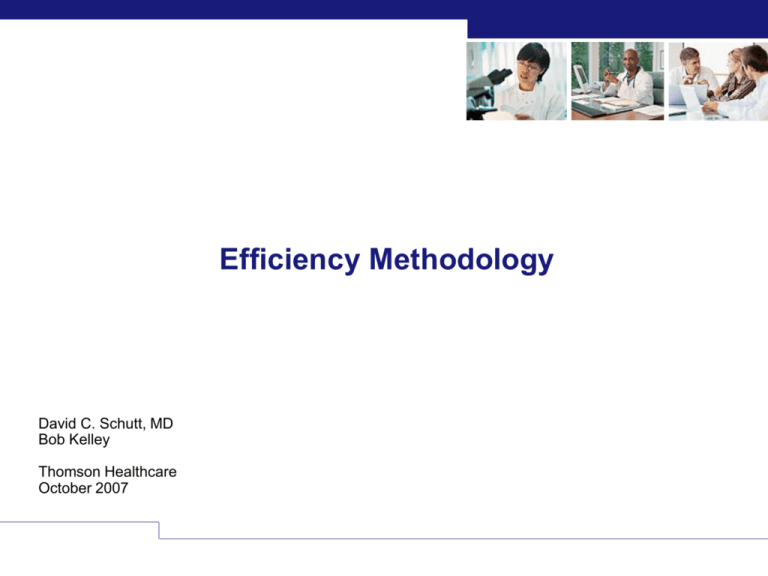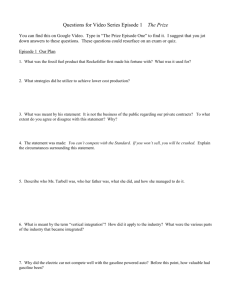
Efficiency Methodology
David C. Schutt, MD
Bob Kelley
Thomson Healthcare
October 2007
Overview
• Definition
• Clinical Grouping Methods
• Implementation Considerations
• Reporting to Physician Organizations
• Example Analysis: Hypertension
©2007 Thomson Healthcare. All rights reserved.
‹#›
Definition
Output
Inputs
Episode
Services
©2007 Thomson Healthcare. All rights reserved.
‹#›
Clinical Grouping
• Clinical Condition
• Episode building
• Accounting for Comorbidities
©2007 Thomson Healthcare. All rights reserved.
‹#›
Disease Staging Methodology
©2007 Thomson Healthcare. All rights reserved.
‹#›
Disease Staging Framework
• Initially developed under contract to NCHSR with ongoing private
development by Medstat/Jefferson teams
• Software converts a stream of claims into clinically homogeneous
groups
• Takes over 15,000 ICD-9-CM codes to 560 disease categories
• Independent of setting or treatment
• Etiology assigned to each category
• Severity stratification based on robust clinical criteria
• Predicts a balanced set of outcome measures
©2007 Thomson Healthcare. All rights reserved.
‹#›
Disease Staging
Disease Staging Severity Stratification
Stage 0
History of a disease
Stage 1
Conditions with no complications or problems of
minimal severity
Stage 2
Problems limited to an organ system; significantly
increased risk of complications
Stage 3
Multiple site involvement; generalized systemic
involvement; poor prognosis
Stage 4
Death
©2007 Thomson Healthcare. All rights reserved.
‹#›
Cardiovascular
Clinical Criteria for Disease Staging
DISEASE:
Coronary Artery Disease with prior Coronary Revascularization
ETIOLOGY:
Degenerative, Genetic
STAGE
DESCRIPTION
DIAGNOSTIC FINDINGS
CVS 10
ICD-9-CM CODES
1.1
Coronary atherosclerosis Coronary atherosclerosis
Dx V4581, 99603, 41402-41407; (Dx
or asymptomatic
OR asymptomatic chronic ischemic heart disease
41181, 412, 41400-41405, 4292) +
chronic ischemic heart
OR old myocardial infarction
(Dx V4581, 99603)
disease or old
OR history of myocardial infarction 30 days old
myocardial infarction
AND ejection fraction 50% [echocardiogram report or nuclear ejection
fraction report]
1.2
Chronic stable exertional Chronic stable exertional angina
(Dx 4139, 4148-4149) + (Dx V4581,
angina or chronic
OR chronic ischemic heart disease
99603)
ischemic heart
disease
Progressing angina
Progressing angina pectoris
(Dx 4110, 41189) + (Dx V4581, 99603)
pectoris or exertional
OR exercise induced myocardial ischemia at < 6 METS [stress test
myocardial ischemia
report]
at low workload or old
OR history of prior myocardial infarction 30 days
myocardial infarction
AND left ventricular ejection fraction < 50% [echocardiogram report or
with low ejection
nuclear ejection fraction report]
fraction
AND left ventricular ejection fraction >= 30% [echocardiogram report or
nuclear ejection fraction report]
Prinzmetal’s variant
Change in nature of onset of symptoms and severity of known anginal pain Dx 4130-4131 + (Dx V4581, 99603)
angina
AND past history of angina
OR angina occurring at rest
AND ST-T elevations at time of pain [EKG report]
OR Prinzmetal’s variant angina
2.1
2.2
©2007 Thomson Healthcare. All rights reserved.
‹#›
Medical Episode Grouper (MEG)
Methodology
©2007 Thomson Healthcare. All rights reserved.
‹#›
Episodes of Care
• Health care is typically provided in a series of separate but related
services
• All of these services must be included to produce a comprehensive
economic analysis of care provided to patients
• Using an episode approach enables an assessment of costs of care
and lends itself to the analysis of the processes as well as the
outcomes of care
Source: Hornbrook MC, Hurtado AV and Johnson RE, Health care episodes:
definition, measurement and use, Medical Care Review 42:2 (Fall 1985)
©2007 Thomson Healthcare. All rights reserved.
‹#›
Episode Construction
• Case Mix Adjustment - Diagnosis codes from health care claims and
other administrative data are grouped into one of over 560 Disease
Staging disease categories and severity stages
• Clean periods unique to each disease category are used to develop
boundaries around the episode
• Mappings of National Drug Codes (NDCs) and laboratory/diagnostic
procedure codes enable pharmacy/lab/diagnostic claims to be grouped
to relevant episodes
• Lab and diagnostic imaging claims preceding an episode are examined
to determine whether they should be combined with the episode
©2007 Thomson Healthcare. All rights reserved.
‹#›
MEG—Putting it All Together
Episode 10
CAD,
Progressive
Angina
Look-back
Lab
Prescription
Clean Period
Hospital
Office
Office
Admission
Visit
Visit
Office
Visit
DRUG TRANSACTION FILE
PATID
NDC
01
ISDN
01
INSUL
01
INSUL
01
AMOX
01
AMOX
01
GRHORM
SERVDATE
95-01-15
95-02-15
95-04-15
95-04-15
95-11-15
95-11-15
LOOKUP TABLE
NDC
EPGRP
ISDN
10
INSUL
359
INSUL
360
INSUL
361
AMOX
484
AMOX
86
©2007 Thomson Healthcare. All rights reserved.
‹#›
Coronary Artery Disease Episodes
Stage
Description
Episodes
Mean Payments
1
Stable Angina
80,470
$2,657
2
Progressive Angina
14,599
$11,017
3
AMI
7,749
$16,811
102,818
$4,911
Total
MarketScan 2002
©2007 Thomson Healthcare. All rights reserved.
‹#›
Patient-Level Complexity Adjusted Episodes
©2007 Thomson Healthcare. All rights reserved.
‹#›
The Challenge
62 year old, Male
Patient A
Progressive Angina
2005 Costs ~ $15,323
Comorbidities
• Congestive Heart Failure
• Type 1 Diabetes
• Vascular disease
• Renal failure
Relative Risk Index = 29.62
Patient B
58 year old, Female
Progressive Angina
2005 Costs ~ $5,576
Comorbidities
• Hypertension, minimal
Relative Risk Index = 2.54
Patients with at the same severity
level within an episode can have
significant cost variance….
...due to different comorbidity profiles.
©2007 Thomson Healthcare. All rights reserved.
‹#›
Episodes and Patient-Level Risk Adjustment
• MEG
– Disease-based episodes of care, e.g., Coronary Artery Disease and
Diabetes
– Disease severity predicated on the progression of medical complications
of a disease, e.g., Coronary Artery Disease:
• Stage 1:
• Stage 2:
• Stage 3:
Stable angina
Progressive Angina
AMI
– Unit of analysis – an episode
©2007 Thomson Healthcare. All rights reserved.
‹#›
Episodes and Patient-Level Adjustment (cont’d)
• Diagnostic Cost Groups (DCGs)
– Risk adjustment methodology used to predict current or future patient
costs, e.g. relative risk score (RRS)
– Unit of analysis – the patient
– Based on all prior or current year claims to identify patient-level
complexity/comorbidities
• Together, MEG and DCGs provide a complete picture of a patient
©2007 Thomson Healthcare. All rights reserved.
‹#›
DCG Model – Clinical Output
ICD-9-CM codes
(n = 15,000+)
DxGroups
(n = 781)
Condition Categories (CCs)
(n= 184)
Hierarchies
imposed for
predictions
• Each ICD-9-CM code maps to one DxGroup
(clinically homogeneous). Most members have
multiple DxGroups.
• CCs are clinical groupings of DxGroups that are
related and imply similar resource use
(organized by body system or disease group).
Each DxGroup maps to only one CC.
• 31 Hierarchies are imposed on the CCs to
produce HCCs. These clinical hierarchies
identify the most costly manifestation of each
distinct disease. A member is only assigned the
highest CC in each hierarchy. A member will
likely have multiple HCCs.
Hierarchical Condition Categories
(HCCs) (n= 31)
Used with permission of DxCG
©2007 Thomson Healthcare. All rights reserved.
‹#›
DCG Relative Risk Score (RRS)
Risk Categories
62 year old male
Relative
Risk Score
.45
HCCs
Diabetes with renal manifestations
Type 1 diabetes
Congestive heart failure
Unstable angina
5.71
.95
1.84
.92
Vascular disease with complication
1.20
Vascular disease
0 (h)
Dialysis status
Diabetes with congestive heart failure
18.09
.46
29.62
Used by permission DxCG®, Inc.
©2007 Thomson Healthcare. All rights reserved.
‹#›
Coronary Artery Disease: Severity Stages and
Complexity Levels
Complexity Levels – RRS Ranges
Mean Allowed Payments
Disease
Severity
Stage
A
B
C
D
E
Stable Angina
1
$1,080
$1,424
$1,679
$1,940
$2,246
Progressive Angina
2
$5,974
$8,704
$10,825
$13,173
$13,173
Acute Myocardial Infarction
3
$11,041
$15,041
$15,041
$18,423
$18,423
Source: Medstat Health Plan Customer, 83 million claims, 2003-2004
©2007 Thomson Healthcare. All rights reserved.
‹#›
Dimensions of Risk – Coronary Artery Disease
$20,000
Mean Allowed
Payments
$15,000
$10,000
$5,000
$0
A
B
C
D
E
Complexity Levels - RRS Ranges
Episode Severity Stages
1 - Stable Angina
2 - Progressive Angina
3 - AMI
Source: Medstat Health Plan Customer, 83 Million Claims, 2003-2004
©2007 Thomson Healthcare. All rights reserved.
‹#›
Episode 496
Asthma
Which Physician is most Efficient?
Dr. A
Clean Period
Look-back
Test
Drug
Office
Office
Hospital
Dr. B
Clean Period
Look-back
Test
Drug
Office
Drug
Office
Office
Office
Office
Clean Period
Dr. C
Drug
Office
Drug
Drug
Drug
Drug
Office
Drug
Implementation Issues
• Standardized Pricing
– Capitated encounters do not contain actual charges
– Appropriate standard costs are developed to convert utilization to dollars
– For example, Resource Based Relative Value Units to convert CPT codes to dollars
• Outlier Trims
– Exclude episodes with extreme high and low costs (top and bottom percentiles)
• Ensuring Stability and Reliability
– Minimum sample size per analytic unit (30 episodes but for full scale test results will
report all episodes, regardless of sample size)
– Risk adjustment process applies statistical methods to ensure reliability
• Comparisons to Norms and Benchmarks
– Internal norms vs external norms
– Geographic differences to be evaluated
• Attribution:
– Enrollment information from health plans used to attribute members to POs (requires
continuous one year enrollment)
©2007 Thomson Healthcare. All rights reserved.
‹#›
Standardized Pricing
Service Type
Coding
Standard Pricing
Methodology
Notes
CMS DRG Relative Weights
and LOS Groups
Scaled by MarketScan™-based conversion
factor
Facility Inpatient
DRG
Facility Outpatient
CPT,
HCPCS
CMS APC and ASC weights
Scaled by MarketScan™-based conversion
factor
Professional Fee
CPT
CMS RBRVU weights
CMS RBRVU weights, conversion factor
Lab/Radiology/
Ancillary
CPT
CMS RBRVU weights
CMS RBRVU weights, conversion factor
Pharmacy
NDC +
Quantity
Average Allowed Price
MarketScan™ Average (NDC + Quantity)
©2007 Thomson Healthcare. All rights reserved.
‹#›
Physician Organization Reporting
Reporting Results to Physician Organizations
Objectives:
1. Provide meaningful information about overall performance in all efficiency
measures
2. Provide enough information to make results actionable, targeting areas for
improvement.
Report Formats:
1. Summary document (.pdf) of PO results and relevant benchmark
information for all efficiency measures:
– Generic prescribing
– Population-base efficiency
– Episode-based efficiency
– Efficiency by selected clinical area
2. Excel file of episode results, with detail at episode group level and service
type.
3. Reference documentation with information on all measures and methods
©2007 Thomson Healthcare. All rights reserved.
‹#›
Levels of Aggregation
• Methodology produces a common “building block” that can then be
aggregated in different ways to produce different measures/measure
breakdowns
• Building block is, for each patient episode, the risk adjusted
comparison of actual to expected costs by service type:
–
–
–
–
Inpatient
Pharmacy
Outpatient
etc.
• See following slide for illustrative example
©2007 Thomson Healthcare. All rights reserved.
‹#›
Illustrative Episode-Level Results
A
B
Episode
Patient ID
C
D
Episode
Disease Stage
E
Relative Risk
F
Complexity
Score
Level
29.62
5
Start Date
12345
25-Jan-06
10 - Coronary Artery
Disease
G
Total Observed
(Standard)
Inpatient Costs
H
Total Expected
(Standard)
Inpatient Costs
I
Inpatient Cost-
$12,000
$6,300
2.1
Progressive
Angina
K
Total Expected
(Standard)
Pharmacy Costs
L
Pharmacy Cost-
Efficiency
J
Total Observed
(Standard)
Pharmacy Costs
1.90
$1,200
$2,400
0.50
M
Total Observed
(Standard)
Outpatient Costs
N
Total Expected
(Standard)
Outpatient Costs
O
Outpatient
CostEfficiency
P
Total Observed
(Standard) Costs
$3,500
$4,473
0.78
$16,700
Efficiency
Q
Total Expected
R
Overall
Episode Cost(Standard) Costs
Efficiency
$13,173
1.27
Note: Cost Efficiency = Observed/Expected. Therefore, lower rate is better. Final calculation algorithm TBD.
©2007 Thomson Healthcare. All rights reserved.
‹#›
Level of Aggregation – Service Type: Example
• For all episodes assigned to a group for the measurement year, can:
– Sum total expected costs for each service type
– Sum total observed costs for each service type
– Divide observed by expected costs to get score for each service type and
total
• Service types include:
–
–
–
–
–
–
–
Inpatient
Prescription Drug
Office Visit
ER
Lab
Radiology
Outpatient Surgery
• Final set of service types to be informed by pilot test results
©2007 Thomson Healthcare. All rights reserved.
‹#›
Summary Report
P4P Efficiency Domain Summary – Full Scale Test
Reporting Year: 2007
Measurement Year: 2006
Physician Organization Name, DMHC #
1.4
Efficiency Score
1.33
1.3
1.25
1.25
1.2
1.2
1.1
1.0
0.8
…etc.
Pharmacy…etc.
Pop-Based
Efficiency
Overall
EpisodeBased
Efficiency
Inpatient
Episode 1
By Clinical Area
0.7
0.6
0.63
Episode-Based by Service Category
©2007 Thomson Healthcare. All rights reserved.
‹#›
Population-Based Efficiency Summary
Group
Number of Members
Group A
7,000
Percentile
Ave Observed
(Standardized)
Cost/Member
$6,000
Number of Members
Ave Expected (Standardized)
Cost/Member
Overall Efficiency
$5,000
1.20
Ave Observed (Standardized)
Cost/Member
Overall Efficiency
Minimum
10th percentile
25th percentile
50th percentile
Mean
75th percentile
90th percentile
Maximum
Standard Deviation
©2007 Thomson Healthcare. All rights reserved.
‹#›
Episode-Based Efficiency Summary
Group
Group A
Percentile
Number of
Episodes
50,000
Ave Observed (Standardized)
Cost/Episode
Average
Expected (Standardized)
Cost/Episode
Overall Efficiency
$500
$400
1.25
Number of Episodes
Ave Observed (Standardized)
Cost/Episode
Overall Efficiency
Minimum
10th percentile
25th percentile
50th percentile
Mean
75th percentile
90th percentile
Maximum
Standard Deviation
©2007 Thomson Healthcare. All rights reserved.
‹#›
Episode Efficiency by Service Type
Group
Number
of
Episodes
Group
A
50,000
Ave
Observed
(Standard)
Inpatient
Cost/Ep
isode
Percentile
$150
Ave
Expected
(Standard)
Inpatient
Cost/E
pisode
$120
Inpatient
Efficiency
Ave
Observ
ed
(Standard)
Pharmacy
Cost/Episode
Ave
Expec
ted
(Standard)
Pharmacy
Cost/Episod
e
1.25
$100
$160
Inpatient
Efficiency
Pharmacy
Efficiency
Pharmacy
Efficiency
Ave
Obser
ved
(Standard)
Office Visit
Cost/
Episo
de
Total
Expect
ed
(Standard)
Office Visit
Cost/E
pisode
0.63
$140
$180
.etc
etc.
Overall
CostEfficiency
Ave Observed
(Standard)
Cost/Episode
Ave
Expec
ted
(Standard)
Cost/
Episo
de
Overall
CostEfficien
c
y
$500
$400
1.25
Avg Observed
Cost per
Episode
Minimum
10th percentile
25th percentile
50th percentile
Mean
75th percentile
90th percentile
Maximum
Standard Deviation
©2007 Thomson Healthcare. All rights reserved.
‹#›
Excel File of Episode Results
•
•
One row for each Episode Group (560 groups) (e.g. Essential Hypertension)
Data Elements:
–
–
–
–
–
–
–
–
–
–
–
•
Episode name
Type (e.g. Chronic)
Number of Episodes
Total Observed Cost
Mean Observed Cost
Mean Expected Cost
Overall Efficiency Index
Percent of Episodes
Percent of Costs
Mean Episode Length
Observed and Expected Costs and Efficiency Score by Service Type
Summary Group Roll-Ups
–
Episode Summary Group (192 groups)
–
Body System
©2007 Thomson Healthcare. All rights reserved.
‹#›
Example Analysis of Episodic Efficiency Results:
A Study of Treatment Patterns
•
Standard reports to Physician Organizations will include
service type benchmark data for a number of high impact
episode groups.
•
Considering deeper investigation into specific sources of
variation in costs between high and low performing
benchmark groups.
•
Results could provide useful insights to PO improvement
initiatives.
©2007 Thomson Healthcare. All rights reserved.
‹#›
Study Methodology
•
Select episode groups for investigation:
– High variability in provider results
– High volume
– High cost
•
Calculate overall performance index for each provider (e.g.
physician group)
•
Sort by performance index and categorize into “tiers” (e.g.
quintiles)
•
Profile tiers by service category
– Performance index
– Costs
– Utilization
•
Identify specific sources of variation in costs by service
category
©2007 Thomson Healthcare. All rights reserved.
‹#›
Hypertension:
Average Total $/Episode by Provider Quintile
$0
$250
$500
$750
$1,000
$1,250
$1,500
$1,750
$2,000
$2,250
Q1
Q2
Q3
Q4
Q5
• Average cost per episode is standardized for patient risk
• Excludes outliers and incomplete episodes
©2007 Thomson Healthcare. All rights reserved.
‹#›
Hypertension:
Average $/Episode by Provider Quintile
$0
Q1
Q2
Q3
Q4
Q5
$250
$500
$750
$1,000
$1,250
$1,500
$1,750
$2,000
$2,250
OP
Allowed Amount Epis Admit
Allowed Amount Epis Rx
$821
$955
$1,031
$1,192
$1,341
• Prescription Drug accounts for ~70% of costs
©2007 Thomson Healthcare. All rights reserved.
‹#›
Hypertension Episode Variance Analysis
$200
$161
$150
$79
$100
$50
$0
($13)
($50)
($55)
($100)
($150)
($130)
Q1
Q2
OP Office
Q3
OP Lab
OP Rad
Q4
ER
Admit
Q5
Rx
• As it accounts for the majority of cost, Rx accounts for most of total
variance
• Question: Are high drug costs allowing for efficiency elsewhere?
©2007 Thomson Healthcare. All rights reserved.
‹#›
Hypertension Episode Variance Analysis – No Rx
$25
$20
$15
$10
$5
$0
($5)
($10)
($15)
Q1
Q2
OP Office
Q3
OP Lab
OP Rad
Q4
ER
Q5
Admit
• Similar variation is seen in cost for medical care, particularly for
Quintiles 1 & 5
• Differences in Quintiles 2 – 4 are less consistent
©2007 Thomson Healthcare. All rights reserved.
‹#›
Hypertension:
Provider Variance: Prescription Drug $ per Episode
$1,600
Q1
$714
Q2
$805
Q3
$870
Q4
$1,005
Q5
$1,156
$1,400
$1,200
$1,000
Average: $897
$800
$600
$400
$200
$0
• Sample of 59 providers managing 30+ stage 1.01 hypertension patients
• Prescription drug payments standardized for price and patient risk
©2007 Thomson Healthcare. All rights reserved.
‹#›
Average Prescription Drug $/Epis for 1st and 5th Quintiles
$200
$190
$187
$150
$124
$100
$111
$91
$50
$93
$84
$60
$54
$35
$0
ARB
ACE Inhibitor
Beta Blocker
Q1
Ca Channel
Antiplatelet, NEC
Q5
Compared to Q1, Q5 had higher $/Episode in all 5 major classes
©2007 Thomson Healthcare. All rights reserved.
‹#›
Average Prescription Drug $/Day for 1st and 5th Quintiles
$4
$3.62
$3.88
$3
$2
$2.05 $2.06
$1.84 $1.91
$1
$0.42
$0.76
$0.55
$0.82
$0
ARB
ACE Inhibitor
Beta Blocker
Q1
Ca Channel
Antiplatelet, NEC
Q5
Use of more costly drugs within each class contributed to Q5’s higher costs
©2007 Thomson Healthcare. All rights reserved.
‹#›
Average Days Supply/Episode for 1st and 5th Quintiles
140.0
129.3
120.0
120.2
108.9
100.0
102.3
60.0
40.0
97.6
92.2
80.0
67.5
54.3
20.0
9.6
24.0
0.0
ARB
ACE Inhibitor
Beta Blocker
Q1
Ca Channel
Antiplatelet, NEC
Q5
However, higher use was a greater factor for ARB and Ca Channel drugs
©2007 Thomson Healthcare. All rights reserved.
‹#›
Summary
• Definition
• Clinical Grouping Methods
• Implementation Considerations
• Reporting to Physician Organizations
• Example Analysis: Hypertension
©2007 Thomson Healthcare. All rights reserved.
‹#›







